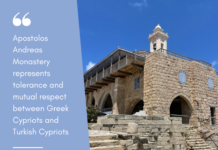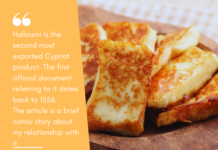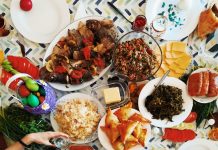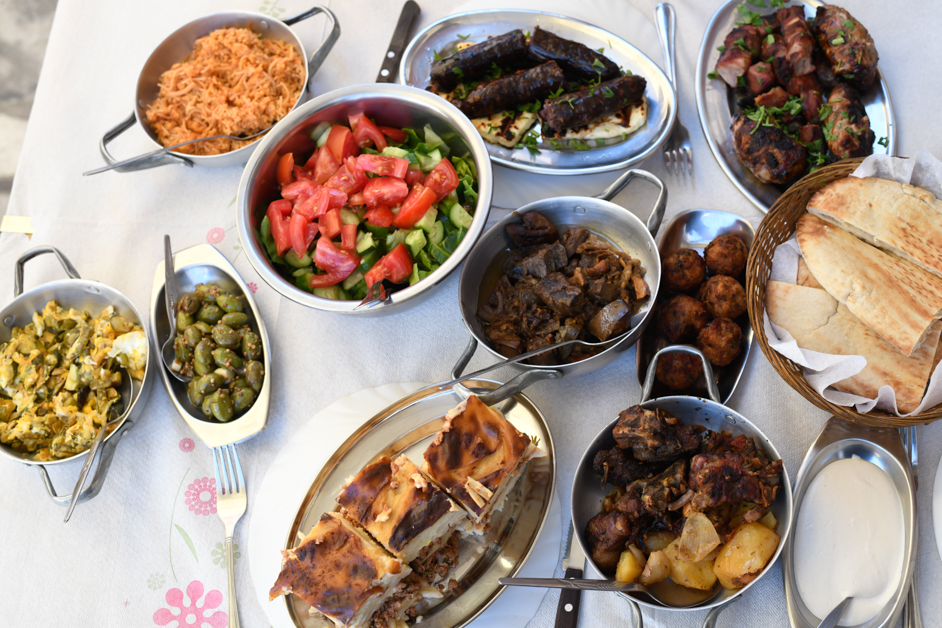In Cyprus, locals eat A LOT of meat. Really, a lot. At mezes restaurants, you will always find yourself not knowing anymore how many types of meat dishes you ate, or how they were cooked, or what kinds of meat you ate. But you are happy, so it’s fine.
Between my vegetarian flatmate and the fact that I’m not sure if it’s recommended to grill inside the house and that I don’t think the neighbours would be happy if I did it in the parking lot, I did not had a chance to delight myself in cooking keftedes or souvla, but that didn’t stop me from trying to reproduce some Cypriot dishes.
I did my first attempt after a morning at the market. A lady, after having offered us zivania for breakfast, persuaded us to absolutely taste traxanas. We bought it without really knowing what it was: from the seller’s explanation, we just understood “yogurt” and “flour”, but we blindly trusted her and we were ready to dive into the local culture. After an afternoon spent studying websites in order to find The Recipe, the most original and truthful one, I got down to work. I followed The Recipe step by step, even daring to make an avgolemono, absolutely necessary according to the 4th recipe I consulted and I even added “cut vermicelli”, as suggested by the market lady. As italian, this was really difficult for me.
My flatmate gave her portion to our cats. They didn’t like it either. When several days later I proudly told my culinary adventure to Tassos, the only Cypriot I knew, he seemed quite upset:”You had it all wrong, and what were you thinking? Adding avgolemono?!”. I didn’t lose hope, despite the disappointment in Tassos’ eyes and the smell of goat (I’ll never understand Cypriots’ hate for cow milk) of traxanas, which 3 months later, still lie in a corner of the cupboard, probably upset, making company to the vermicelli.
 My approaches with kolokasi and poulles have been fortunately guided by my mentor, making the whole process much less traumatic and “gropingly”. What I can say is that peeling and cutting kolokasi is really hard, especially if, like me, you’re using a little knife which dangerously bended every time I tried to cut the root. However, I still have all my fingers, so balancing things out, I’d say it was a success.
My approaches with kolokasi and poulles have been fortunately guided by my mentor, making the whole process much less traumatic and “gropingly”. What I can say is that peeling and cutting kolokasi is really hard, especially if, like me, you’re using a little knife which dangerously bended every time I tried to cut the root. However, I still have all my fingers, so balancing things out, I’d say it was a success.Instead, my mentor’s poulles kai patates antinaxtes recipe was brilliant. I warmly recommend it, especially if you’re stressed, angry or you just need to let off steam. There are three reasons for this. First of all, the recipe requires, in addition to coriander, wine: this provides an excellent excuse to have a drink. Second reason (and most important one) is that, in order to cook this dish, you have to hit raw potatoes. Cross my heart, I thought it was a joke, a figure of speech, I don’t know… No, Cypriot people literally hit potatoes. Since I did it for the first time (personally, with a bottle of wine and with a little hammer), I keep on wondering why I didn’t do it sooner. It was really funny. Third reason: before being cooked in the wine, poulles and potatoes are fried, making this dish a great comfort food.
Why this tale of my (mis)adventures? To tell you that, in order to know a country, a culture, to have a real experience abroad, you also need to try the typical food. So, have a taste! Eat mezes (I suggest Zanetto’s and Mezostrati – just remember to order for less people than you actually are), try the several middle-eastern nice little places you can find around (Avo, Al-Baik, Friend’s Lahmajoun…), go to OXI farmers market, inhale deeply the scent of barbecue and fried onion you can smell through the streets at any time… But also try to test yourself first hand by cooking cypriot dishes, with food you may not never have considered to buy, with recipes you may not never have thought to taste: it’s another great way to get out of your comfort zone!

















